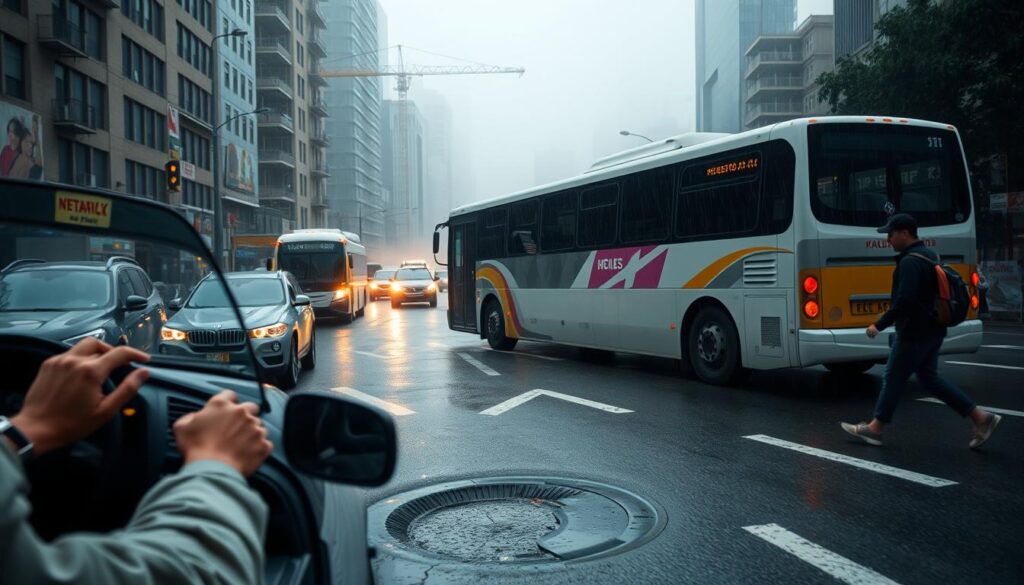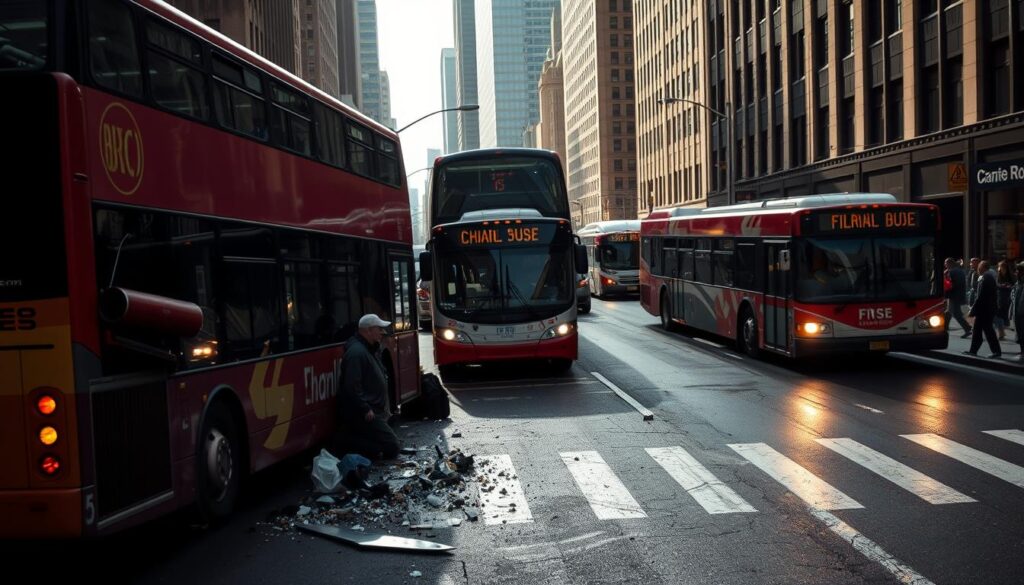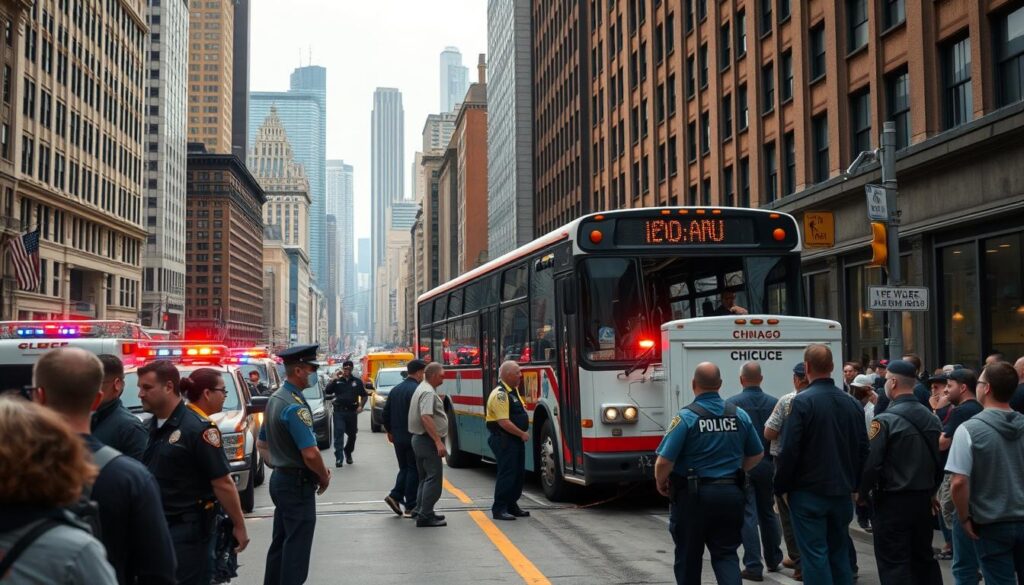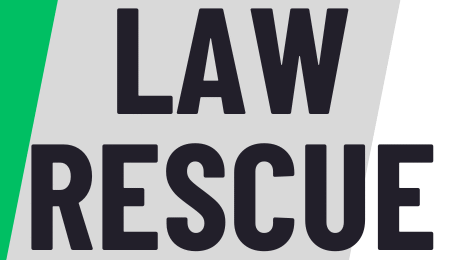Did you know over 1,800 large bus crashes occurred in Chicago last year, leaving hundreds injured? When public transportation fails, victims often face overwhelming challenges—but who fights for their rights when corporations and government agencies push back?
Specialized Bus Accident Lawyers handle these complex cases daily. They navigate unique legal landscapes involving public entities like the CTA, private companies, and strict deadlines. Unlike standard personal injury claims, bus incidents require expertise in common carrier laws and accident reconstruction.
These professionals investigate crashes thoroughly. They gather evidence, interview witnesses, and work with experts to build strong cases. Their goal? Secure compensation for medical bills, lost income, and emotional trauma.
Time matters in these situations. Public transportation claims often have shorter filing windows than standard lawsuits. A skilled attorney ensures paperwork meets all requirements while negotiating with insurers who prioritize profits over fairness.
If you’ve been hurt, focus on healing—let legal experts handle the battle for justice. The right representation makes all the difference in holding responsible parties accountable.
Don’t Make These Mistakes When Selecting a lawyer bus accident
How a Bus Accident Lawyer Can Help You
Navigating the aftermath of a public transportation incident requires skilled guidance. Professionals at firms like Taxman, Pollock, Murray & Bekkerman bring decades of experience handling cases involving Chicago’s transit systems and private operators. Their contingency-based approach means you only pay if they win your case.
Understanding Your Legal Rights
Illinois law holds transportation companies to higher safety standards than regular drivers. Attorneys clarify how these rules apply to your situation, especially when dealing with government agencies. They’ll explain potential roadblocks like immunity protections for public entities.
Guidance Through Complex Claims
Filing deadlines for government-related incidents can be as short as 12 months. Legal teams manage paperwork while countering insurance tactics designed to minimize payouts. They work with medical experts to document all current and future needs.
| Service | Benefit | Timeline |
|---|---|---|
| Free Case Review | No upfront costs | 24-48 hours |
| Evidence Collection | Stronger compensation claims | Ongoing |
| Settlement Negotiation | Maximize recovery | 3-12 months |
Many victims don’t realize how future medical costs impact their financial security. Skilled advocates ensure these factors get included in settlement discussions. They’ll also handle communications with multiple liable parties, from drivers to maintenance contractors.
Common Causes of Bus Accidents
Understanding why collisions happen helps prevent future incidents. Transit vehicle crashes often stem from preventable human errors and corporate decisions that compromise safety standards.

Driver Fatigue and Distracted Driving
Operators working 14-hour shifts with minimal breaks face extreme exhaustion. Fatigue slows reaction times by 40%, increasing risks of lane drifting and delayed braking. Many drivers also manage complex routes while addressing passenger inquiries, creating dangerous multitasking scenarios.
Distractions like adjusting fare machines or navigating tight urban streets further reduce focus. Unlike personal vehicles, transit cabins have constant activity that diverts attention from road hazards.
Mechanical Failures and Inadequate Maintenance
Brake system defects account for 29% of catastrophic crashes in commercial vehicles. When firms delay replacing worn tires or skip fluid checks, essential components fail unexpectedly. Steering malfunctions at high speeds leave operators unable to control large passenger carriers.
Cost-cutting measures often lead to skipped inspections. A 2022 DOT study found 1 in 5 transit fleets had overdue maintenance work. These oversights put everyone at risk—from cyclists sharing roads to families boarding for daily commutes.
How to Choose the Best Bus Accident Lawyer for Your Case
Types of Bus Accident Scenarios
Chicago’s streets see diverse transit-related incidents, each presenting unique legal challenges. Recent events highlight this variety—like a June 2024 CTA collision in Bridgeport involving eleven cars and a building, leaving multiple injured. Understanding these patterns helps victims recognize their rights.

City Transit and Private Bus Incidents
Public transportation mishaps often involve crowded routes and complex liability. CTA and Pace vehicles operating in dense areas like the Loop face higher risks of rear-end collisions and pedestrian impacts. Private shuttle services add another layer, as seen when uninsured operators caused recent injuries near McCormick Place.
School Bus and Charter Bus Crashes
Children’s safety becomes paramount when school transportation fails. Last October, a North Chicago district vehicle rear-ended a semi-truck, underscoring risks during student commutes. Charter services face scrutiny too—one firm transported tourists without valid insurance after a downtown rollover.
Multi-Vehicle Collisions
Large transit vehicles often trigger chain reactions on expressways. The Bridgeport crash demonstrated how momentum multiplies damage—five injuries resulted from one driver’s error. These cases frequently involve multiple insurance providers and conflicting witness accounts.
Key takeaway: Each scenario demands specific evidence-gathering strategies. From traffic camera footage in urban zones to maintenance records for private fleets, thorough documentation proves vital for fair outcomes.
Steps to Take Immediately After a Bus Accident
In the chaotic moments following a collision, knowing what to do can protect both your health and legal rights. Prioritize safety by moving to a secure area if possible, then contact emergency services. This quick response creates an official record while addressing potential injuries.
Documenting the Scene and Gathering Evidence
Take clear photos of vehicle positions, road conditions, and visible harm. Capture traffic signals and skid marks—these details help reconstruct events later. Collect contact information from witnesses and note their observations while memories remain fresh.
Record the operator’s credentials and transit company details. Preserve this data alongside the official police report, which documents initial findings and fault assessments.
Seeking Prompt Medical Attention
Visit a healthcare provider immediately, even without obvious symptoms. Conditions like whiplash or concussions often surface hours later. Medical records create essential links between the incident and your physical condition.
Keep thorough documentation of treatments, expenses, and missed workdays. Avoid discussing fault with insurance representatives until consulting a legal professional who can safeguard your interests.
Navigating Bus Accident Claims in Chicago
Legal deadlines vary significantly between public agencies and private companies in Chicago. When collisions involve multiple entities, untangling responsibility becomes critical for fair outcomes. Transportation incidents often involve overlapping insurance policies and complex liability rules.

Dealing With Multiple Liable Parties
Determining fault often requires examining several groups. Drivers, transit providers, and maintenance crews might share responsibility depending on the situation. For example, a broken brake system could point to both the operator and their equipment vendor.
Government entities like the Chicago Transit Authority add another layer. Their cases require specific evidence collection methods due to strict record-keeping rules. Private firms might have different insurance limits compared to municipal operators.
Understanding Public Versus Private Operators
Filing against the CTA gives you just 12 months to act—half the time allowed for private companies. Public agencies sometimes use immunity defenses, but skilled teams know how to counter these arguments through detailed investigations.
Private carriers face different regulations. Their insurance coverage often includes higher policy limits but requires proving direct negligence. Whether dealing with a city vehicle or charter service, documentation timing impacts your case strength.
Pro tip: Always preserve photos, witness contacts, and repair records immediately. These materials help attorneys identify which parties contributed to the incident and build stronger compensation requests.
Compensation and Recovery Process
Knowing what financial support you qualify for can transform your path forward after traumatic events. Fair settlements address both immediate needs and long-term stability, helping rebuild lives disrupted by others’ negligence.
Recovering Medical Expenses and Lost Wages
Healthcare bills add up quickly—from ambulance rides to years of physical therapy. Compensation covers these costs plus medications and specialist visits. Lost income claims include missed shifts and reduced work abilities down the road.
Severe injuries might prevent returning to your original job. Courts recognize this through earning capacity evaluations, ensuring fair payment for career changes or necessary accommodations.
Pain, Suffering, and Future Care Costs
Non-economic damages matter too. Juries consider daily discomfort, anxiety, and lifestyle limitations when calculating awards. A 2023 study showed these factors account for 38% of typical personal injury settlements.
Future needs require careful planning. Experts project costs for home healthcare, mobility devices, and therapy decades ahead. One recent case secured $2.8 million for a client needing lifelong assistive care after spinal damage.
Documentation proves essential. Save every receipt, doctor’s note, and repair estimate. Strong evidence helps legal teams demonstrate how injuries impacted your world—from family relationships to favorite hobbies.
Unique Challenges in Bus Accident Lawsuits
Resolving transit-related injury claims often feels like solving a puzzle with missing pieces. Public agencies and private companies operate under different rules, creating hurdles that demand specialized legal strategies.
Governmental Immunity and Strict Deadlines
Illinois law gives public transit systems like the CTA special protections. Victims have just 12 months to file claims against government entities—half the time allowed for private companies. While agencies might claim immunity, exceptions apply when negligence contributes to unsafe conditions.
Complexities of Evidence and Liability
Multiple parties often share responsibility in these cases. Maintenance crews, drivers, and contractors could all play roles in what caused the incident. Critical evidence like surveillance footage or vehicle diagnostics often disappears quickly unless preserved immediately.
Successful outcomes depend on understanding how these factors interact. Legal teams must act fast to secure proof while meeting tight deadlines. This approach helps build strong arguments for fair compensation.
FAQ
What function does a bus accident lawyer serve in my case?
They examine the accident, collect evidence such as witness testimonies and surveillance recordings, negotiate with insurance providers, and strive to obtain just compensation for injuries or damages.
In what ways might legal professionals aid in comprehending my rights following a collision?
Lawyers elucidate state statutes, clarify liability regulations, and guarantee compliance with claim filing dates. They also manage intricate documentation and correspondence with relevant parties.
What variables frequently contribute to collisions involving large passenger vehicles?
Fatigue, inattentive operation, inadequate maintenance, and equipment malfunctions are prevalent. Weather or roadway dangers may also contribute to these occurrences.
Do distinct legal frameworks exist for urban transportation incidents compared to school-related accidents?
Affirmative. Public enterprises such as the Chicago Transit Authority has distinct immunity regulations, whereas private operators adhere to conventional liability statutes. Incidents pertaining to educational institutions may necessitate more stringent safety protocols.
What is the significance of prompt medical attention after an incident?
Prompt medical documentation establishes a direct correlation between injuries and the incident, so precluding insurers from contending that your condition sprang from extraneous factors.
What complicates the resolution of claims involving multiple vehicles?
Assessing fault percentages among drivers, operators, and manufacturers necessitates skilled evaluation. The insurer of any party may attempt to attribute liability to others.
Am I eligible to reclaim expenses for prolonged recovery following significant injuries?
Affirmative. Settlements frequently encompass future medical expenses, therapeutic costs, and diminished earning potential if injuries adversely impact your capacity to work permanently.
What is the effect of deadlines on cases involving government-operated transit systems?
Illinois mandates reduced notice periods, as brief as one year, for claims concerning governmental organizations. Neglecting these deadlines may result in the loss of your entitlement to compensation.

